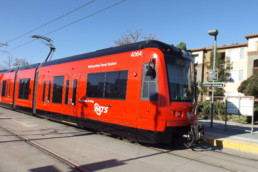Creating Sustainable “Smart Transit” Corridors through Community Engagement
Year Complete: 2015
Grant Amount: $56,250
Local Government: City of San Diego, CA
Local Foundation: The San Diego Foundation
Project Purpose
To gather and incorporate community feedback on active transportation and mixed-use development for light-rail stations.
Key Lessons Learned
Lessons learned about tools and tactics through the project that other sustainability directors could use to advance their work.
One key lesson learned is the importance and value of flexibility. During this project, a number of political and staff changes occurred, which greatly affected work. Yet, in spite of this, The San Diego Foundation (TSDF) was able to build deeper relationships with City staff, which ensured continued partnerships and conversations as elected officials change. As a result, the City and TSDF continued working together, including outreach to communities during the city’s formal planning process in fall 2015.
In addition, flexibility allowed the project to move forward when unknown hurdles emerged. During the beginning of the project, another light rail station planning effort prompted some community opposition because residents did not understand the project and felt they were not included in the process. It was important for the City and TSDF to continue working with each other given TSDF’s more flexible funding, which supported the city in later challenges and opportunities.
Lessons for developing a collaborative process between a local government sustainability director and local place-based foundation(s).
While foundations have a great opportunity to partner more closely with local governments in order to promote sustainability and smart growth, those partnerships are greatly strengthened by complementary community partnership with other nonprofits and community organizations. Unlike local governments and foundations, nonprofits and community organizations have close working relationships with communities, which enable them to create groundswells of neighborhood support. On the other hand, local governments and foundations in many ways have better access to elected officials, local decision-makers, and policy updates. Thus together, the full complement of partners creates a bottom-up and top-down approach to support sustainability.

